
Explosives and Blasting-Part 3
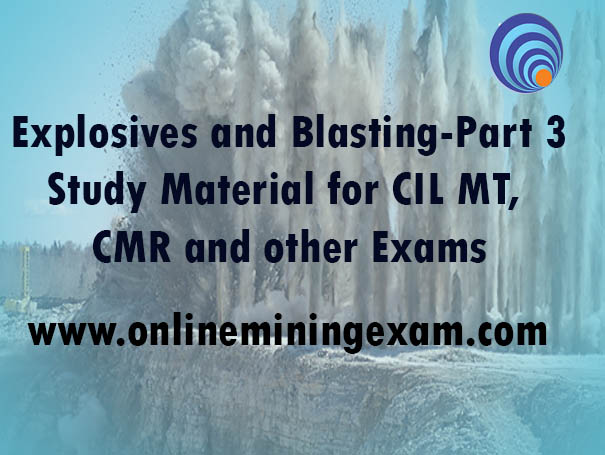
Classifications of firing systems for initiating explosives of different kinds
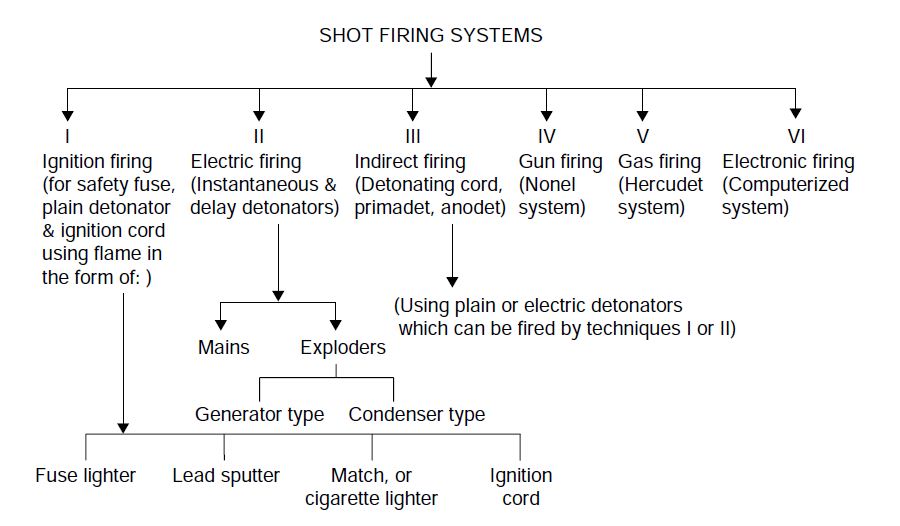
GROUND BLASTING TECHNIQUES
For in-situ blasting different types of explosives and their initiating devices are used. However sometimes secondary blasting is also required. Secondary blasting is required when
- Large size boulders are formed during blasting.
- Jamming of muck in the working stopes underground occurs.

Plaster shooting
In this process the boulder is shot by putting explosive over it and plastering it with a mud cap. Process gives higher powder factor comparing the pop shooting.
Pop shooting
Explosive concentration in small diameter shot holes drilled in the boulder. In this technique in comparison to plaster shooting, better shattering effect with low powder factor can be achieved.
Releasing jammed muck from the draw points
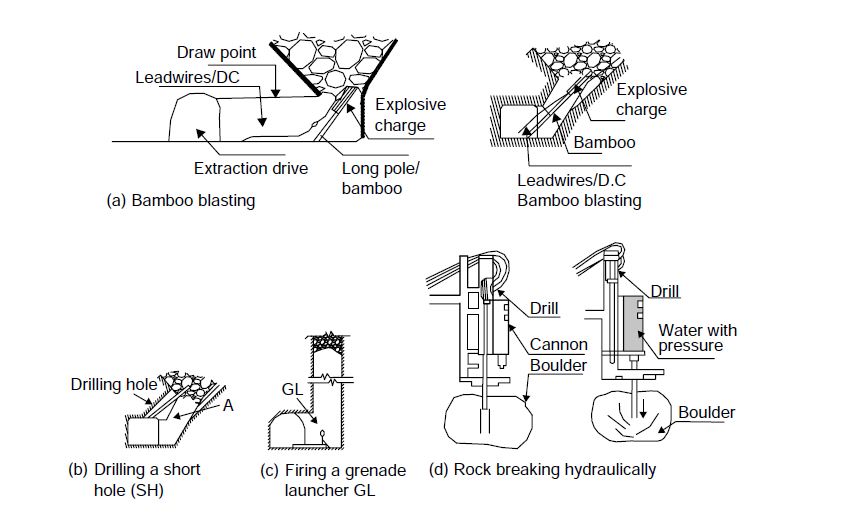
BLASTING THEORY
As shown in [figure (e)], when a cylindrical charge is fired in a blast-hole, the detonation moves up the explosive column from the primer, a high pressure stress wave travels into rock mass. The positions of detonation waves and stress waves are as shown in this figure at different times.
A horizontal section through this charged blasthole, [figure (b)], shows how the area surround hole is divided into radial fractures at different point of time (zones 1 to 5) by the compression shockwaves. These waves from the free face are reflected back as tensile stress waves [figure (b) I – A, B, C; II, III].
Since rocks are weaker in tension than compression, these tension waves cause more and more fracture to rock mass [figure (c)]. Desired fracture or fragmentation will occur when there is proper burden and the rock mass subjected to this phenomenon is free from the natural discontinuities such as fractures, joints etc. In any blasting operation only 3% of the explosive energy is used by the compression wave and the boulders will be generated if this energy is not sufficient to return back after traveling up to the free face. The compression waves only enlarge the radial cracks but tension waves cause the rock to fragment.
The rapid expansion of the gases in the blasthole causes ‘flexture or bending’ [figure (c) and (d)]. The gas pressure also causes radial crack through the rock mass up to the burden and then its displacement.
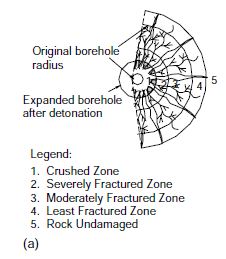


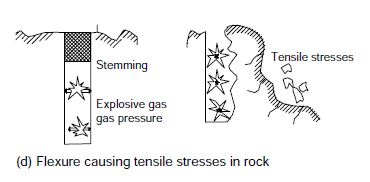

ROCK BREAKAGE MECHANISM
In the fragmentation of rocks with explosives at least eight breakage mechanisms are involved, with more or less responsibility, but they all exert influence upon the results of the blasting.
a. Crushing of rock
In the first instants of detonation, the pressure in front of the strain wave, which expands in cylindrical form, reaches values that well exceed the dynamic compressive strength of the rock, provoking the destruction of its intercrystalline and intergranular structure.
b. Radialfracturing
During propagation of the strain wave, the rock surrounding the blasthole is subjected to an intense radial compression which induces tensile components in the tangential planes of the wave front. When the tangential strains exceed the dynamic tensile strength of the rock, the formation of a dense area of radial cracks around the crushed zone that surrounds the blasthole is initiated.
c. Reflection breakage or spalling
When the strain wave reaches a free surface two waves are generated, a tensile wave and a shear wave. This occurs when the radial cracks have not propagated farther than one third the distance between the charge and the free face. Although the relative magnitude of the energies associated with the two waves depends upon the incident angle of the compressive strain wave, the fracturing is usually caused by the reflected tensile wave. If the tensile wave is strong enough to exceed the dynamic strength of the rock, the phenomenon known as spalling will come about, back towards the interior of the rock.
d. Gas extension fractures
After the strain wave passes, the pressure of the gases cause a quasi-static stress field around the blasthole. During or after the formation of radial cracks by the tangential tensile component of the wave, the gases start to expand and penetrate into the fractures. The radial cracks are prolonged under the influence of the stress concentrations at their tips.
e. Fracturing by release-of-load
Before the strain wave reaches the free face, the total energy transferred to the rock by initial compression varies between 60 and 70% of the blast energy. After the compressive wave has passed, a state of quasi-static equilibrium is produced, followed by a subsequent fall of pressure in the blasthole as the gases escape through the stemming, through the radial cracks and with rock displacement. The stored Stress Energy is rapidly released, generating an initiation of tensile and shear fractures in the rock mass.
f. Fracturing along boundaries of modulus contrast of shear fracturing
In sedimentary rock formations when the bedding planes, joints etc., have different elasticity modulus or geomechanic parameters, breakage is produced in the separation planes when the strain wave passes through because of the strain differential in these points.
g. Breakage by flexion
During and after the mechanisms of radial fracturing and spalling, the pressure applied by the explosion gases upon the material in front of the explosive column makes the rock act like a beam embedded in the bottom of the blasthole and in the stemming area producing the deformation and fracturing of the same by the phenomena of flexion.
h. Fracture by in-flight collisions
The rock fragments created by the previous mechanisms and accelerated by the gases are projected towards the free face, colliding with each other and thereby producing additional fragmentation.
Keywords- Pop shooting, plaster shooting, bamboo blasting, rock breakage, radial fracturing, flexion
Join online test series for GATE MINING 2017 at http://www.onlineminingexam.com







Comments